Index

Review: A rock solid alternative to Brazos nettops
Following the success of its Atom and Brazos based Edge HD systems, Sapphire has decided to introduce a new mini-PC with a twist. This time around, Sapphire decided to go for Intel's Sandy Bridge based Celeron 847, instead of the usual E-series AMDs APU and Atoms found in previous Edge HD models.
The Edge HD4 uses the same chassis as the Edge HD3 that we had a chance to review here, meaning the Edge HD4 is still one of the smallest fully featured PCs. The dimensions are 193 x 148 x 22mm and it weighs a mere 530g, about the same as an average tablet.
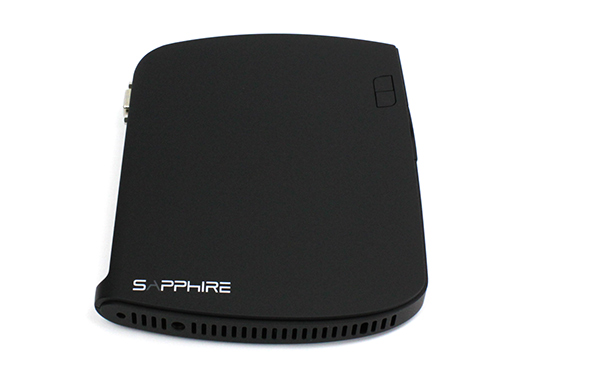
The Edge HD4 is powered by Intel’s dual-core Celeron 847 CPU clocked at 1.1GHz and the chip features embedded DX10 ready graphics. This CPU hails from the previous Sandy Bridge generation, built using Intel’s 32nm process. The current Ivy Bridge generation is in 22nm, but bear in mind that AMD’s Brazos 2.0 is a 40nm part, while Atoms are still stuck at 32nm.
The CPU is coupled with Intel’s NM70 chipset and the processor is integrated on the motherboard. It has a TDP of 17W, which is the norm in this market segment and it is roughly on par with Brazos chips. Low voltage chips don’t offer top notch performance, but they are not meant to. The HD4 is fast enough to handle full HD video and the usual Office suite, but we will get to the performance a bit later.
The Edge HD4 ships with 4GB of DDR3 memory and a 320GB hard drive. It has features VGA and HDMI video outputs, along with built in wireless and a sole USB 3.0 port. It does does not ship with preinstalled Windows and potential buyers should bear this in mind.
|
Specification |
|
|
CPU |
Intel® Celeron® Processor 847 |
|
Memory |
4 GB DDR3 So-DIMM |
|
Storage |
320 GB SATA 2.5'' Hard Drive |
|
Graphics |
Intel® HD Graphics |
|
LAN |
10/100/1000 Mbps Built-in Ethernet |
|
Wireless |
802.11b/g/n Built-in Wireless Network |
|
I/O |
1 x HDMI Port |
|
Power |
65W W AC 100~240V 50/60Hz, DC 19V~3.42A |
|
Dimensions |
19.3 x 14.8 x 2.2 cm (L / W / H) |
|
Weight |
530 g net weight |
|
Operating System |
Pre-installed Free DOS |
The Edge HD4 ships in a small and refreshing blue box. The blue is an obvious hint that the system is based on an Intel CPU. The outer and inner packaging is made from 100% recycled paper, so you can rest assured that no Amazonian three-toed sloths were left homeless because you chose to buy a new PC.
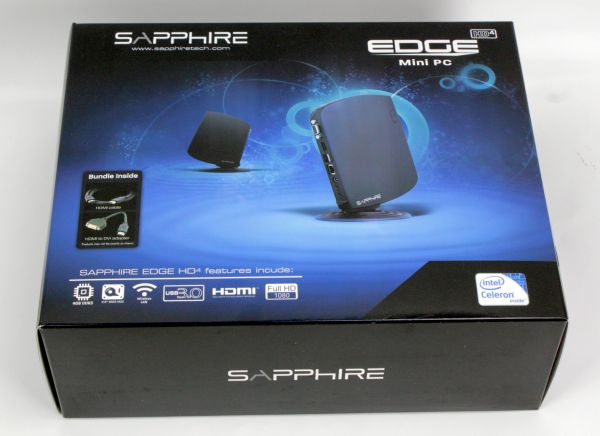
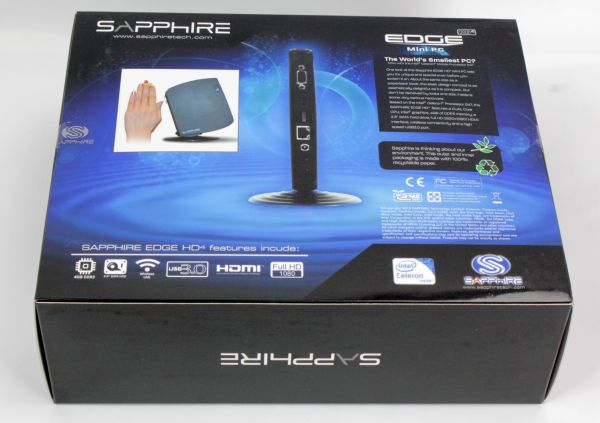
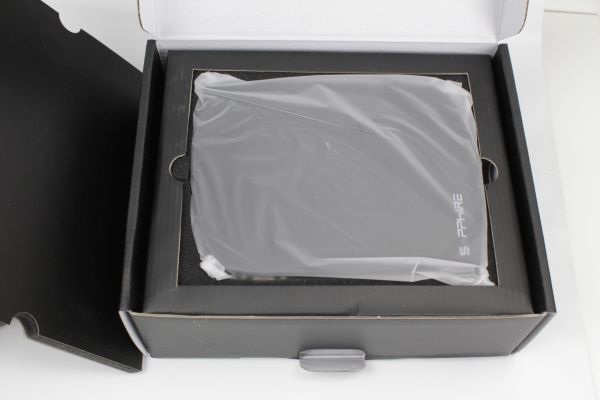
The box contains a power cord with adapter, one HDMI cable (1.5m), an HDMI to DVI adapter, desktop base, driver-CD, quick installation guide and information regarding product registration (Sapphire Select Club).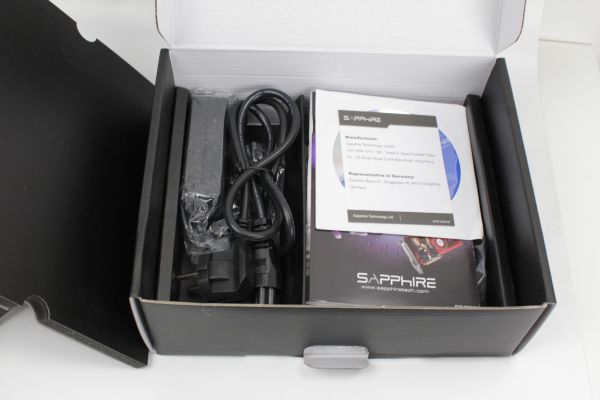
Like we said, the Edge HD4 does not ship with Windows and FreeDOS is what you get preinstalled. That is not what end-users need and most will choose an appropriate version of Windows or Linux to power the HD4. The quick installation guide describes how to change boot device priority in order to boot from a pen drive or USB DVD drive in order to install a different operating system. Needless to say, we opted for Windows.
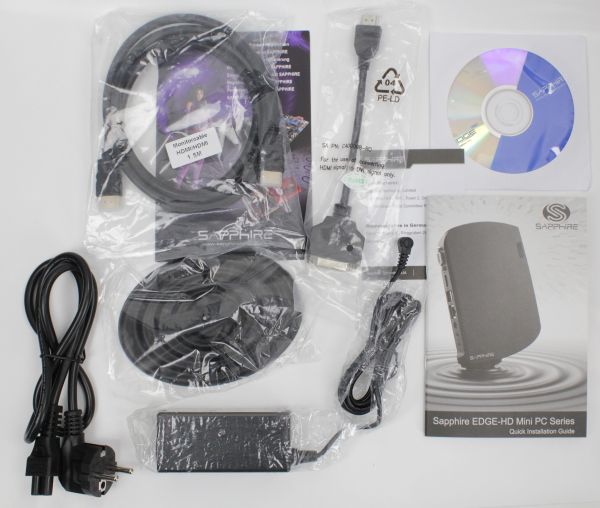
The Edge HD4 is based on the same miniature chassis as the Edge HD3. In terms of aesthetics and build quality, we have no complaints. However, during our HD3 review we noticed that it can generate quite a bit of noise. The HD4 is a different beast, with a different CPU, so things could be different this time around.
The right mirrors the left side and the only difference is that there are no buttons on this side.
You will notice that there are no air vents on either side, so the HD4 relies on a few openings at the bottom and top to ensure airflow. This also means that it needs to be mounted upright to ensure proper cooling, as hot air will naturally circulate from the bottom to the top of the chassis.
One of the first things you will have to do when setting up the Edge HD4 is to attach the desktop stand.
The desktop stand is made from metal and it has the thumb screw in the middle. All you have to do is align the stand with the base of the Edge HD4 and twist the screw firmly into place, much like on any monitor. Once it’s installed on the stand the Edge HD4 ends up in vertical position, but in spite of the low weight the whole rig feels pretty stable.
Sapphire decided to ship a VESA mount only with the new Edge VS, series but not with the Edge HD4 and Edge HD3. With a VESA mount we could easily place the Edge HD4 on the back of a TV. Sadly, with the transition to thin and stylish monitors with LED backlighting, VESA mounts are going out of fashion quicker than Gangnam Style. Most monitors no longer support them due to their thin design.
Sapphire did not use cheap, glossy plastics for the Edge HD4 / Edge HD3. Instead, it opted for a rubberized matte finish. It feels durable and looks pretty nice, too.
The power button is the only button on the Edge HD4. It features a power indicator light underneath. The HDD activity indicator is the same size as the power button and it’s is placed right next to it. There is no reset switch, which is the case with most other nettops or small-PCs as well.
The HD4 features one USB 3.0 port that will come in quite handy for speedy external storage. The Edge HD3, which is AMD-based, comes with two USB 3.0 ports.
The USB 3.0 port is placed at the front, along with a USB 2.0 port but they are not visible. They are hidden under a little protective flat as shown on the image below. The cover is held in place with a rubber catch so it will not be lost.
On the rear of the unit you will find the rest of the ports, including video outs, one RJ-45 Gigabit Lan, two USB 2.0 ports, one Line-in (3.5mm jack), one Audio-out (3.5mm jack), and DC In connector. Sapphire opted for one HDMI and one VGA output. DVI displays can be connected using the HDMI to DVI adapter. The bundled HDMI cable is 1.5 meters long. Nothing out of the ordinary here.
In case you are wondering why the video connectors, which use relatively heavy cables, are not placed at the bottom for added stability, the answer is simple. The connectors are placed close to the CPU, which also houses the embedded graphics core. In order to facilitate better cooling, the CPU is placed near the top, which means hot air won’t have to circulate around the chassis to exist the top vent.
Some vendors ships wireless adapter in a form of a USB stick but Sapphire decided to use built-in wireless (802.11n) adapter. We think it’s a better solution.
We appreciate the fact that Sapphire decided to place all audio connectors at the back. This is not always the case with nettops, and although some users like to have easy access to audio jacks for headphones, placing the jacks at the back is a much better choice for HTPCs connected to a bunch of speakers. Nobody likes to see their new toy behind a bunch of cables and that’s why we were surprised by the decision to place the only USB 3.0 connector at the front.
Taking the HD4 apart requires more attention and caution than skill. Still, it’s necessary to follow some simple steps, but be warned – in case you get a full system rather than a barebone, disassembly will void the warranty. The covers can be removed using a thin, flathead screwdriver. However, the avoid scratches it might be a better idea to use an old ATM card. Start by removing the back cover, the one with the sticker.
Look at the picture below to see locations of the small latches that need to be unhinged.
After the back cover is removed it is possible to access the rest of the screws (one screw is located under the warranty sticker).
The next step is to remove the screws surrounding the VGA connector, after which it is possible to remove the front cover.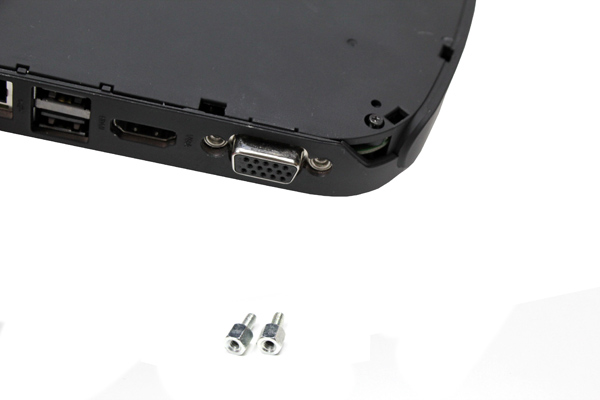
Removing the front cover should be a smooth affair. In case you encounter too much resistance, it’s probably an indication that you missed a screw. Once again, use a plastic card instead of a screwdriver to protect the surface from scratches.

Note the low profile heatsink and small GPU/CPU fan.

The Edge HD4 ships with a single 4GB DDR3-1333 SO-DIMM module and a 320GB 5400rpm hard drive, courtesy of Western Digital.
The Western Digital Scorpio Blue WD3200BPVT 320GB 5400 RPM 8MB Cache 2.5" SATA 3.0Gb/s usually comes with laptops and is considered ‘stock’ drive and it is meant for daily computing. The same goes for the Samsung Spinpoint M7E HM321HI 320GB, which we encountered in the HD3. We were hoping for a somewhat faster drive this time around, but on the upside the WD is very quiet and you we did not notice any noise whatsoever.

The WD3200BPVT drive uses Advanced Format Technology that is being adopted by WD and other drive manufacturers to increase media format efficiency, thus enabling larger drive capacities. Advanced Format drive uses 4KB sectors instead of 512 byte sectors, allowing for greater platter density and therefore fewer platters & faster sequential read/writes.

The bios is relatively simple and it doesn’t offer many options. It is impossible to change the CPU and memory clocks.
The Edge HD4 comes with preinstalled FreeDOS, which is basically like old MS-DOS, but a bit better, which really isn’t saying much. FreeDOS can be very useful sometimes, but you can run only programs intended for MS-DOS or for FreeDOS. You can check software list here.
The Edge HD4 does not ship with preinstalled Windows. The approach allows users to use their own copy of Windows, or install Linux in any flavor. However, most consumers are not tech savvy and they might need some help in this department. The decision not to ship Windows also helps keep the retail price down.
Our OS of choice was Windows 8 Pro 64-bit. If you do not want to buy a license for the operating system right now, you can install a trial version of Windows first. For example you can download a 90-days test version of Windows 8 here.
A word of caution for XP lovers. The Edge HD4 comes with WD3200BPVT hard drive. This drive uses Advanced Format Technology and if you're installing Win XP system on this drive, you must download Western Digital's "WD Align" software, here, to format the drive prior to Win XP installation. Windows Vista, Windows 7 and Windows 8 users can ignore this part and format the drive just like any other.
Since the system ships without an optical drive, you can install Windows from a bootable USB stick. The Windows 7 USB/DVD download tool comes in handy when you need to create a bootable USB stick from ISO file (you can find it here).
Our bootable USB was recognized correctly after inserting it into USB 3.0. We decided to delete partition with FreeDOS because it used up 150GB and the whole partition was formatted in FAT32.

All the drivers are supplied on a disc which is included in the box. Try not to lose it, because the Edge HD4 drivers are not available online, at least for now.
Unlike most mini-PC systems, Sapphire’s Edge HD4 is powered by Intel’s Celeron 847, so it should be faster than similar systems based on Atom chips. Intel’s dual-core Celeron 847 CPU is clocked at 1.1GHz.

Since the embebed graphics relies solely on system memory, the decision to go for 4GB of system memory is a good idea.
In case you missed it, the Celeron 847 is actually the first ULV budget CPU based on Sandy Bridge architecture. It has 2MB of L3 cache and does not support Hyper-Threading or Turbo Boost. It has a 17W TDP, supports dual-channel DDR3-1333 memory and comes with an integrated DirectX 10 graphics controller that runs at 350MHz (800MHz Turbo).
A quick note on Futuremark benchmarks: 3DMark 11, 3DMark Vantage, 3DMark06 and PCMark 7 are compatible with Windows 8 when using the latest SystemInfo component. These benchmarks prompt you to install new SystemInfo updates or you can download and install SystemInfo yourself from the Futuremark website.
3DMark 06
3DMark 06 shows us that Intel's HD 3000 graphics are not on par with AMD APUs. Even the ancient ION2 is better.
3DMark
PCMark7
However, in PCMark 07 the Edge HD4 takes a clear lead against other mini-PCs that we had a chance to test. We ran the computation test several times and the score was always superior to what we saw on othe systems. In terms of sheer CPU power, the dual-core Celeron 847 is certainly faster than AMD's E-450, as well as the 1.8GHz D525 Atom. As we noted earlier, the main disadvantage of the Celeron 847 is its lacklustre GPU performance, but it more than makes up for it thanks to impressive CPU scores.
Cinebench R11.5
Cinebench R11.5 pretty much confirms our previous tests and Sapphire’s Edge HD4 with its Celeron 847 CPU ends up faster than Edge HD 3 with E-450 as well as the Sapphire Edge HD2 with Intel Atom D525+ION2 combo. Once again we see that the GPU is the weakest link. It is one of the slowest GPUs we had a chance to come across in mini-PCs.
HD Tune
The results we saw earlier mostly depend on the choice of HDD storage. The Edge HD4 clearly steams ahead of the ZBox Nano XS AD11 Plue E-450 APU which uses 64GB mSATA SSD, but in some tests it lags behind by a wide margin. Of course, nothing stops the user from going for a speedier 7200rpm 2.5-inch HDD, or even a hybrid drive or SSD and get some impressive numbers on that side as well.
Aida64
We used the Edge HD4 for some casual browsing, media playback and even some office work while it remained connected to a 1080p TV. It handled everything that we threw at it with ease.
Cooling is a challenge in all small and slim PCs and as you already had a chance to see, the size of the heatsink and fan is limited by the size of the chassis.
As the graphics core is integrated in the CPU, the whole cooling system consists of a single heatpipe with a heatsink and fan. The HD4 needs to be mounted upright to provide the best possible airflow. Now for some good news. We are happy to report that the HD4 is quieter than the HD3. It is still possible to hear the fan under load, but it really did not bother us much, although it is still audible in complete silence, at night.
It’s not possible to adjust the fan speed in bios. At default settings the CPU temperature is 38°C in idle, but under load it can hit 66°C, while the graphics part goes up to 70°C. These results are pretty good, especially when compared to the HD3.
The Celeron 847 is a frugal low voltage processor is designed with mobile gear in mind, so it has a TDP of just 17W. Power consumption is pretty low as according to our measurements the HD4 consumed 15W in idle and up to 34W under full load. This is a few watts more than the HD3, but all in all the results are very impressive, since it offers more performance as well.
The Edge HD4 looks like all previous HD-series systems, which means it is tiny and can be placed just about anywhere. It is also a bit quieter than the HD3, although it is still not the quietest mini-PC out there.
The really big difference is the choice of CPU. Although the Celeron 847 fails to match the graphics performance of AMD APUs, the Sandy Bridge CPU cores do a pretty good job in non-graphics tests. Intel’s HD 3000 graphics are DirectX 10.1 capable, while AMD E-series APUs feature DirectX 11 graphics. Since it is very unlikely that anyone will use a mini-PC for gaming, it seems like a fair tradeoff.
The Edge HD4 is currently only available as prebuilt unit, and just like previous HD-series systems, it features a sluggish, 5400rpm hard drive. If you choose to replace it, you will void the warranty. We believe Sapphire should have provided alternatives, such as SKUs with hybrid drives, or small SSDs. It is also worth noting that the HD4 ships without an OS, which will undoubtedly put off mainstream consumers who are not tech savvy.
All in all the Edge HD4 is a pretty good rig with an interesting CPU, which makes it a very interesting alternative to Atom and Brazos based systems. The power consumption is low, it is quieter than other HD-series systems and in some benchmarks, it is noticeably faster.
